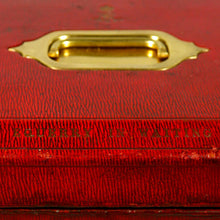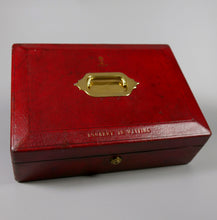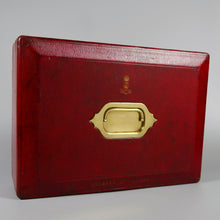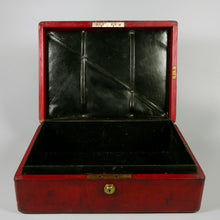An Edwardian Courtier’s Despatch Box, 1902
Adding product to your cart
Measurements: 39cm (15.3in) x 27.5cm (10.8in) x 13cm (5in)
Red leather over wood, with swing handle to the hinged lid. The leading chamfered edge embossed ‘Equerry in Waiting’. The interior stamped with the maker’s name of H.M. Stationer, Wickwar & Co., 6 Poland Street, London. The lock bearing the stamp of Bramah, London.
Read more
The Household of Edward VII numbered some eight equerries and fourteen extra equerries. However it appears only two courtiers fulfilled the role of Equerry-in-Waiting, the Hon. S.J. Fortescue, and the Hon. H.C. Legge.
Captain Hon. Sir Seymour John Fortescue (1856-1942) was the son of 3rd Earl Fortescue, and entered the Navy in 1869. He was Lieutenant of Superb at the bombardment of Alexandria, during the Egyptian War of 1882 and was Lieutenant of Sphinx during the naval and military operations in the Eastern Sudan, at Suakin before and after the fall of Khartoum in early 1885. He served in Naval Intelligence Department from 1891 until April 1893 when was appointed Equerry-in-Waiting to the Prince of Wales. He was awarded the C.V.O., on 22 Jun 1897, on the commemoration of Queen Victoria's Diamond Jubilee. He was Naval Aide-de-Camp to Field Marshal Lord Roberts during the South African War for which he was mentioned in despatches and awarded the C.M.G. Appointed Equerry-in-Waiting to King Edward VII on the occasion of the Coronation, on 9 August 1902, he was knighted (K.C.V.O.) in 1910. He served as Equerry to King George V, 1910 to 1936, Edward VIII, 1936, and to King George VI, 1936 to 1942. He was also Sergeant-at-Arms in the House of Lords, 1910 to 1936, and Naval Censor in the Official Press Bureau during the First World War. He was advanced to G.C.V.O. in 1931. His long service to the Royal Family is recalled in his autobiography ‘Looking Back’ (1920) and he penned the foreword to A.E.T. Watson’s ‘King Edward VII as a Sportsman’.

Photo: A. Debenham, Cowes, S J. Fortescue, Cowes, 1893
Colonel Hon. Sir Henry Charles Legge (1852-1924) was the son of the 5th Earl of Dartmouth and was commissioned into the Coldstream Guards. He served in the Sudan during in the Suakin Campaign of 1885, where he was mentioned in despatches. He was appointed of Groom-in-Waiting to Queen Victoria in 1889, and 1893 became Equerry-in-Waiting. In 1901 became Equerry-in-Waiting to Edward VII. He was Registrar and Secretary of the Order of Merit, and an Extra Equerry-in-Waiting to George V from 1915. He was Paymaster of the Household between, 1915-20, and a member of Orders of St. Stanislaus of Russia; the Redeemer of Greece; Isabella of Spain and the Portuguese Order of Christ. Like Fortescue, he was appointed Knight Grand Cross, Royal Victorian Order (G.C.V.O.) in 1920.

Haakon VII, King of Norway with Sir Henry Charles Legge.












